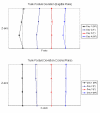Smart garment for trunk posture monitoring: A preliminary study
- PMID: 18489789
- PMCID: PMC2423362
- DOI: 10.1186/1748-7161-3-7
Smart garment for trunk posture monitoring: A preliminary study
Abstract
Background: Poor postures of the spine have been considered in association with a number of spinal musculoskeletal disorders, including structural deformity of the spine and back pain. Improper posturing for the patients with spinal disorders may further deteriorate their pain and deformities. Therefore, posture training has been proposed and its rationale is to use the patient's own back muscles to keep the spine within the natural curvature. A posture training device may help to facilitate this therapeutic approach by providing continuous posture monitoring and feedback signals to the patient when "poor" posture is detected. In addition, the users of the device may learn good postural habits that could carry over into their whole life.
Methods: A smart garment with integrated accelerometers and gyroscopes, which can detect postural changes in terms of curvature variation of the spine in the sagittal and coronal planes, has been developed with intention to facilitate posture training. The smart garment was evaluated in laboratory tests and with 5 normal subjects during their daily activities.
Results: Laboratory tests verified that the accuracy of the system is < 1 degrees and < 1.5 degrees in static and dynamic tilting measurements respectively. The results showed that the smart garment could facilitate subjects to prevent prolonged poor postures of the spine, especially the posture of the lumbar spine in which at least 40% of the time in poor posture were reduced.
Conclusion: The smart garment has been developed to be a portable and user-friendly trunk posture monitoring system and it could be used for collection of the trunk posture information and provision of instant feedback to the user if necessary for posture training purpose. The current pilot study demonstrated that the posture of normal subjects could be monitored and trained via this smart garment. With further clinical investigations, this system could be considered in some flexible spinal deformities such as scoliosis and kyphosis.
Figures






References
-
- Dworkin B, Miller NE, Dworkin S, Birbaumer N, Brines ML, Jonas S, Schwentker EP, Graham JJ. Behavioral method for the treatment of idiopathic scoliosis. Proceedings of the National Academy of Sciences of the United States of America. 1985;82:2493–2497. doi: 10.1073/pnas.82.8.2493. - DOI - PMC - PubMed
LinkOut - more resources
Full Text Sources
Other Literature Sources

